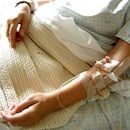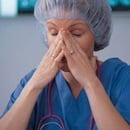
Getting a Handle on Depression: Treatment Options for MDD
Major Depressive Disorder (MDD) is a psychiatric disorder characterized by a depressed mood or a decreased interest or pleasure in normal activities. The prevalence rate for MDD ranges from 10 to 20 percent for adults in the United States. Adults between the ages of 18 and 29 experience the highest rates of depression, although it can occur at any age. Women have higher rates of depression compared to males. Depression, along with suicide, clusters in families with an individual being at 1.5 to 3 times greater risk of developing depression if a first-degree relative is diagnosed with the disorder. Several theories exist regarding the cause of depression; however, the main neurotransmitters implicated in this disorder are serotonin and norepinephrine.
The diagnosis of depression requires five or more symptoms to be present for a two-week period and represents a change from previous functioning. Symptoms include Depressed mood; decreased interest or pleasure in normal activities; weight loss or weight gain; insomnia or hypersomnia; psychomotor agitation or retardation; fatigue or loss of energy; feelings of worthlessness; inability to concentrate, or recurrent thoughts of death. Additionally, the depression must produce a functional impairment and not be due to a substance or a general medical condition. Physical symptoms (aches, pains, fatigue) are often reported by depressed patients and tend to be the motivating factor in seeking help.
Patients will often first present to a primary care physician for treatment of these physical symptoms and often times their MDD is either misdiagnosed or inappropriately treated. The use of screening tools, such as the Beck Depression Inventory and the Patient Health Questionnaire, are encouraged to improve the recognition and diagnosis of depression. Patients reporting depressive symptoms should also be screened for suicide, especially in individuals who are male, single, have a comorbid substance use disorder or a medical condition, have feelings of hopelessness, and have either attempted suicide or have a plan.
The core management of MDD focuses on the use of antidepressants. Psychotherapy and electroconvulsive therapy (ECT) are other treatment modalities but they are most often used in combination with an antidepressant. There are numerous antidepressants available on the market. First-line treatment options for depression include selective serotonin reuptake inhibitors (SSRIs), serotonin-norepinephrine reuptake inhibitors (SNRIs), bupropion, and mirtazapine. Both the SSRIs and SNRIs have been commonly associated with adverse effects including insomnia, headache, gastrointestinal upset, and sexual dysfunction.
Of the SSRIs, paroxetine and fluoxetine pose the greatest risk for drug-drug interactions. Recently, the Food and Drug Administration (FDA) capped the dose of citalopram at 40 mg for adults and 20 mg for elderly patients due to risks of QTc prolongation. Of the SNRIs, duloxetine is also FDA-approved for diabetic peripheral neuropathy and fibromyalgia. Mirtazapine, which works by increasing serotonin and norepinephrine, is associated with causing sedation and weight gain. Bupropion produces its antidepressant effects by blocking the reuptake of norepinephrine and dopamine. Common side effects of bupropion include insomnia, agitation, and anxiety. Bupropion is considered the least likely to cause sexual dysfunction and is often used in combination with other antidepressants to improve this adverse effect. Bupropion is contraindicated in individuals with epilepsy or an eating disorder.
Vilazodone is the newest antidepressant available. In addition to being a serotonin reuptake inhibitor, vilazodone acts as a partial agonist at serotonin 1A receptors. Common adverse effects of vilazodone are similar to other antidepressants including headache, diarrhea, gastrointestinal upset, and insomnia, but with less sexual dysfunction.
The tricyclic antidepressants (TCAs) and the monoamine oxidase inhibitors (MAOIs), both older antidepressants, are reserved for patients who have failed treatments with other antidepressants.
Antidepressants produce their effect within four to eight weeks following treatment initiation. It is recommended that these medications are dispensed at the beginning using a low dose and then titrated slowly over several weeks to the maximum tolerated dose. Treatment should continue for a period of one year following the first episode of depression, then continued indefinitely if the depression relapses. Antidepressants should be tapered slowly over the course of weeks to months to prevent drug withdrawal. Lastly, all patients prescribed antidepressants should be screened for suicide and suicidal thinking since these medications carry a black-box warning for increased suicidal ideation.
Biography:
Andrew Muzyk, Pharm D, is an Assistant Professor at Campbell University College of Pharmacy & Health Sciences in Buies Creek, North Carolina, and practices as a Clinical Pharmacist at Duke University Hospital, where he specializes in Internal Medicine and Psychiatry. In 2012 he joined RxSchool.com, where he presents live courses and contributes to the site’s CE curriculum.
References:
Adams SM, Miller KE, Zylstra RG. Pharmacologic management of adult depression. Am Fam Physician 2008; 77:785-792, 795-796.
Deplin [package insert]. Covington (LA): PAMLAB, 2011 Oct.
Vilazodone: In major depressive disorder. CNS Drugs 2011; 25:615-627.
Wiehs K, Wert JM. A primary care focus on the treatment of patients with major depressive disorder. Am J Med Sci. 2011; 342:324-330




